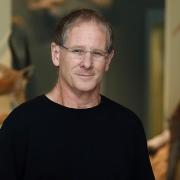Kolodny O, Lotem A & Edelman S Learning a generative probabilistic grammar of experience: a process-level model of language acquisition, Cognitive Science , in press.
Kolodny O, Edelman S, & Lotem A 2014. The evolution of continuous learning of the structure of the environment. J. R. Soc. Interface . Published online January 2014, doi: 10.1098/rsif.2013.1091. PDF
Lotem A & Biran-Yoeli I, 2014. Evolution of learning and levels of selection: a lesson from avian parent-offspring communication. Theoretical Population Biology. 91:58–74. PDF
Lotem A & Kolodny O, 2014. Reconciling genetic evolution and the associative learning account of MNs through data-acquisition mechanisms (Commentary on: Mirror neurons: From origin to function by Cook et al. ). Behavioral and Brain Sciences. In press.
Ilan T, Katsnelson E, Motro U, Feldman MW & Lotem A. 2013. The role of beginner’s luck in learning to prefer risky patches by socially foraging house sparrows. Behavioral Ecology 24: 1398-1406. PDF
Vortman Y, Lotem A, Dor R, Lovette I, & Safran RJ. 2013. Multiple Sexual Signals and Behavioral Reproductive Isolation in a Diverging Population. The American Naturalist 182: 514-523. PDF Media
Belmaker A, Motro U, Feldman MW, and Lotem A 2012. Learning to choose among social foraging strategies in adult house sparrows (Passer domesticus). Ethology 118:1-11. PDF
Lotem A, and Halpern J Y. 2012. Co-evolution of learning and data acquisition mechanisms: a model for cognitive evolution.Philosophical Transactions of the Royal Society, B. 367:2686-2694. PDF
Lotem A, 2012. Learning to avoid the behavioral gambit. Behavioral Ecology. doi: 10.1093/beheco/ars087. PDF
Dor R., R. J. Safran, Y. Vortman, A. Lotem, A. Mc.Gowen, M. R. Evans and I. J. Lovette. 2012. Population genetics and morphological comparisons of migratory European (Hirundo rustica rustica) and sedentary East-Mediterranean (H. r. transitiva) Barn Swallows. Journal of Heredity. 103: 55-63. doi: 10.1093/jhered/ESR114. PDF
Katsnelson E, Motro U, Feldman MW, and Lotem A. 2012. Evolution of learned strategy choice in a frequency-dependent game. Proc. Roy. Soc. Lond. B . 279:1176-84. PDF
Dor R., I. J. Lovette, R. J. Safran, S. M. Billerman, G. Huber, Y. Vortman, A. Lotem, A. Mc.Gowen, M. R. Evans, C. B. Cooper, and D. W. Winkler. 2011. Low variation in the polymorphic Clock gene poly-Q region despite population genetic structure across Barn Swallow ( Hirundo rustica) populations. PLoS ONE 6(12):e28843. doi: 10.1371/journal.pone.0028843.PDF
Arbilly M, E, Motro U, Feldman MW, and Lotem A. 2011. Recombination and the evolution of coordinated phenotypic expression in a frequency-dependent strategy game. Theoretical Population Biology. 80(4): 244-255. PDF
Vortman Y, Lotem A, Dor R, Lovette I, and Safran RJ, 2011. The sexual signals of the East-Mediterranean barn swallow(Hirundo rustica transitiva): a different swallow tale. Behavioral Ecology. 22: 1344-1352. PDF
Grodzinski U, Dor R, and Lotem A. 2011. Begging for a better future: how far can behavioral ecologists go without specifying mechanisms? Behavioral Ecology 22: 921-922. PDF
Arbilly M, Motro U, Feldman MW, and Lotem A. 2011. Evolution of social learning when high expected payoffs are associated with high risk of failure. J. R. Soc. Interface. 8:1604-1615. PDF
Katsnelson E, Motro U, Feldman MW, and Lotem A. 2011. Individual-learning ability predicts social-foraging strategy in house sparrows. Proc. Roy. Soc. Lond. B. 278: 582-589. Link to PDF.
Arbilly M, E, Motro U, Feldman MW, and Lotem A. 2010. Co-evolution of learning complexity and social foraging strategies. J. Theor. Biol. 267: 573-581. PDF
Dor R. and Lotem A. 2010. Parental effort and response to nestling begging in the house sparrow: repeatability, heritability, and parent-offspring co-evolution. Journal of Evolutionary Biology, 23: 1605-1612. PDF
Goldstein MH, Waterfall HR, Lotem A, Halpern JY, Schwade J, Onnis L, and S. Edelman, 2010 General cognitive principles for learning structure in time and space, Trends in Cognitive Sciences 14: 249-258. PDF
Grodzinski U, Hauber ME, and Lotem A. 2009. The role of feeding regularity and nestling digestive efficiency in parent-offspring communication: an experimental test. Functional Ecology, 23: 569-577. PDF
Dor R. and Lotem A. 2009. Heritability of nestling begging intensity in the house sparrow ( Passer domesticus). Evolution, 63-3:738-748. PDF
Shafir S, Reich T, Tsur E, Erev I, and Lotem A. 2008. Perceptual accuracy and conflicting effects of certainty on risk-taking behaviour. Nature 453: 917-920 First paragraph | Full Text | PDF (221K) See also: Making the paper: Arnon Lotem Nature podcast: interview with Ido Erev, media coverage
Lotem A. and Halpern J.Y. 2008. A Data-Acquisition Model for Learning and Cognitive Development and Its Implications for Autism. Cornell Computing and Information Science Technical Reports http://hdl.handle.net/1813/10178. PDF
Grodzinski U, Erev I, and Lotem A, 2008. Can hungry nestlings be trained to reduce their begging? Behavioral Ecology 19: 116-125 Abstract PDF
Katsnelson E, Motro U, Feldman MW, and Lotem A. 2008. Early experience affects producer-scrounger foraging tendencies in the house sparrow. Animal Behaviour, 75: 1465-1472 Abstract PDF
Adar E, Lotem A. and Barnea A, 2008. The effect of social environment on singing behavior in the zebra finch (Taeniopygia guttata) and its implication for neuronal recruitment. Behavioural Brain Research 187: 178-84 (Available online 17 September 2007) Abstract PDF
Grodzinski U, Lotem A. 2007. The adaptive value of parental responsiveness to nestling begging. Proceedings of the Royal Society of London B. 274 (1624): 2449-56 Abstract PDF
Dor R., Kedar H., Winkler WD. & Lotem 2007. Begging in the absence of parents: a "quick on the trigger" strategy to minimize costly misses. Behavioral Ecology, 18: 97-102 Abstract PDF
Munichor N., Erev I. & Lotem A. 2006 Risk attitude in small timesaving decisions. Journal of Experimental Psychology: Applied. 12: 129-141. Abstract PDF
Werner N.Y. & Lotem A. 2006. Experimental evidence for male sequential mate preference in a lekking species. Ethology112: 657-663. Abstract PDF
Ben-Dov A., Vortman Y. & Lotem A. 2006. First documentation of sibling cannibalism in a small passerine species. Ibis 148: 365-367. Abstract PDF ( video link)
Lotem A. & Winkler DW. 2005 Defining the Concept of Public Information. Science 308: 354. PDF
Lotem A. & Winkler DW. 2004 Can reinforcement learning explain variation in early infant crying? Behavioral and Brain Sciences 27: 468. Abstract, PDF
Werner N.Y., Balshine-Earn S., Leach B. & Lotem A. 2003. Helping opportunities and space segregation among helpers in co-operatively breeding cichlid. Behavioral Ecology. 14:749-756 Abstract, PDF
Fishman MA, Stone L & Lotem A. 2003 Fertility assurance through extrapair paternity, and male paternity defense. J. Theor.Biol. 221:96-107. Abstract, PDF
Werner N.Y. & Lotem A. 2003 Choosy males in a haplochromine cichlid: first experimental evidence for male mate choice in a lekking species. Anim. Behav. 66:293-298. Abstract, PDF
Lotem A, Fishman M.A., & Stone L. 2003 From reciprocity to unconditional altruism through signaling benefits. Proc.Roy. Soc. Lond. B. 270:199-205. Abstract, PDF
Ovadia O, Pinshow B. & Lotem A. 2002 Thermal imaging of house sparrow nestlings: the effect of begging behavior and nestling rank. The Condor 104:837-842. Abstract , PDF
Fishman M.A., Lotem A & Stone L. 2001 Heterogeneity stabilizes reciprocal altruism interactions. J. Theor. Biol. 209, 87-95.Abstract , PDF
Kedar H., Rodriguez-Girones M., Yedvab S., Winkler DW & Lotem A. 2000. Experimental evidence for offspring learning in parent-offsrping communication. Proc. Roy. Soc. Lond. B. 267, 1723-1727. Abstract , PDF
Lotem A., Fishman A. M., & Stone L. 1999. Evolution of cooperation between individuals. Nature 400:226-227. (seeElectronic appendix) Abstract , PDF
Rodriguez-Gironez M., Lotem A. 1999, How to detect a cuckoo egg: a signal detection theory model for recognition and learning. Amer. Natur. 153: 633-648. Abstract , PDF
Lotem A. Wagner R.H. & Balshine-Earn S. 1999, The overlooked signaling component in non-signaling behavior. Behavioral Ecology. 10: 209-212. Abstract , PDF
Lotem A. 1999 Manipulative begging by parasitic cuckoo nestlings and paradoxical host behaviour: a reply to Redondo.Trends in Ecology and Evolution. 14: 107. Abstract , PDF
Lotem A. 1998. Manipulative begging calls by parasitic cuckoo chicks: why should true offspring not do the same? Trends in Ecology and Evolution. 13: 342-343. Abstract , PDF
Lotem A. 1998. Differences in begging behaviour among barn swallow (Hirundo Rustica) nestlings. Anim. Behav. 55:809-818.Abstract , PDF
Lotem A. 1998. Brood reduction and begging behaviour in the Swift Apus apus;no evidence that large nestlings restrict parental choice. Ibis 140:507-511. Abstract
Lotem A. 1998. Higher levels of begging behavior by small nestlings: a case of a negatively correlated handicap. Israel J. of Zool. 44:29-45. Abstract , PDF
Balshine-Earn S., Lotem A. 1998. Experimental evidence for individual recognition from video playbacks in a cooperatively breeding cichlid (Neolamprologus brichardi). Behaviour 135:1-18 Abstract, PDF
Rodriguez-Gironez M., Lotem A. 1998. Acceptance by the splendid fairy-wren of parasitism by Horsfield's bronze-cuckoo: re-examination of Brooker and Brooker equilibrium model. Behavioral Ecology 9:419-420. Abstract, PDF
Lotem A., & Nakamura H., 1998. Evolutionary equilibria in Avian brood parasitism: an alternative for the "arms race-evolutionary lag" concept. In Parasitic birds and their hosts: studies in coevolution. Ed. by S.I. Rothstein and S.K. Robinson, pp. 223-235. Oxford University Press. Oxford. Abstract
Lotem A. & Rothstein S.I. 1995. Cuckoo-host coevolution: from snapshots of an arms race to the documentation of microevolution. Trends in Ecology and Evolution 10:436-437. Abstract , PDF
Lotem A., Nakamura H. & A. Zahavi. 1995. Constraints on egg discrimination and cuckoo-host coevolution. Anim. Behav. 49:1185-1209. Abstract , PDF
Lotem A. 1993. Secondary sexual ornaments as signals: the handicap approach and three possible problems. Ethologia3:209-218. Proceedings of the XXIII International Ethological Conference, Torremolinos, Spain (An invited plenary lecture).Abstract , PDF
Lotem A. 1993. Learning to recognize nestlings is maladaptive for cuckoo Cuculus canorus host. Nature 362:743-745.Abstract , PDF
Lotem A., Nakamura H. & A. Zahavi. 1992. Rejection of cuckoo eggs in relation to host age: a possible evolutionary equilibrium. Behavioral Ecology 3:128-132. Abstract, PDF
Lotem A., Schechtman E. & G. Katzir. 1991. Little egrets' Egretta garzetta capture of submerged prey: Strike depth, strike angle and possible effects of light refraction. Anim. Behav. 42:341-346. Abstract, PDF
Katzir, G., Lotem, A. & N. Intrator. 1989. Stationary underwater prey missed by reef herons, Egretta gularis: head position and light refraction at the moment of strike. J. Comp. Physiol. A. 165:573-576. Abstract, PDF


